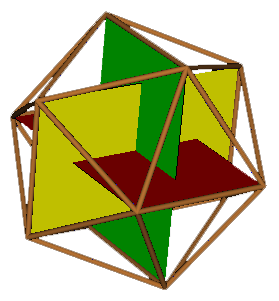
Phi in the icosahedron and dodecahedron
The golden ratio (phi) is defined as (sqrt(5)+1) / 2 and is approximately equal to 1.618...
Phi occurs repeatedly in the construction of the icosahedron and dodecahedron. A simple example shows how phi occurs in the co-ordinates of these polyhedra
The twelve vertices of the icosahedron can all be
defined by placing three orthogonal rectangles with side ratio phi:1 at the
origin. If we define t = phi/2, the resulting co-ordinates are then
(�t, ��, 0), (��, 0, �t) and (0, �t, ��).
The vertices of the dodecahedron can be formed in a similar fashion, in this case place three orthogonal rectangles with side ratio phi�:1 at the origin. if we define u=phi�/2, the resulting twelve co-ordinates are then (�u, ��, 0), (��, 0, �u) and (0, �u, ��). The remaining eight vertices can then the formed by placing a cube of side length phi at the origin with its faces parallel to the planes of the rectangles. With t = phi/2 as before, the resulting co-ordinates are then (�t, �t, �t).
I am indebted to Daud Saum's book 'Polyhedra' [ref] for bringing these relationships to my attention.